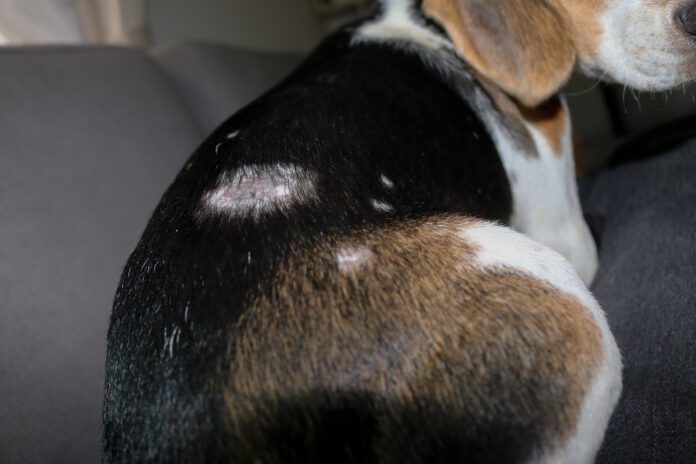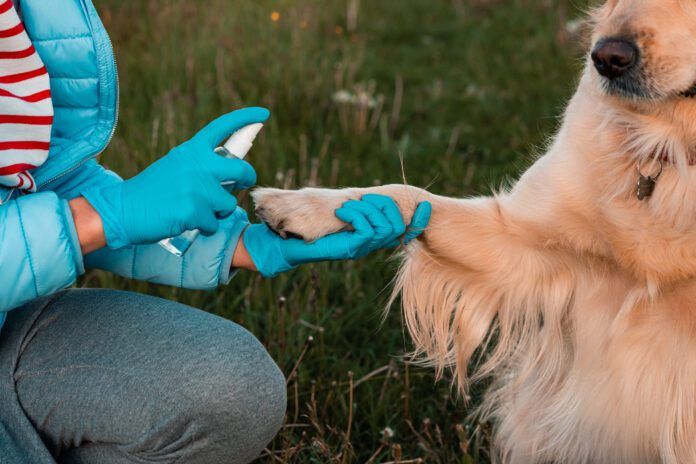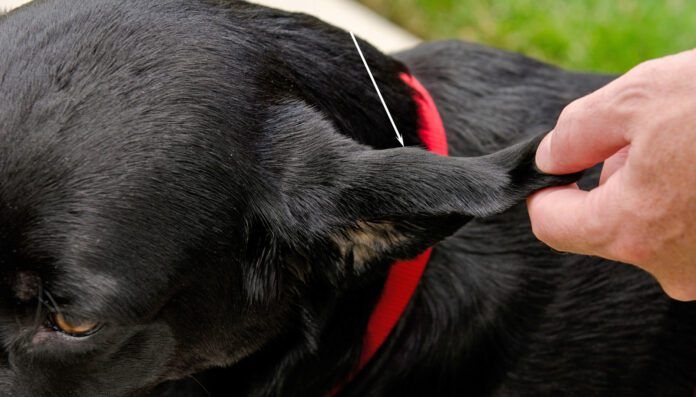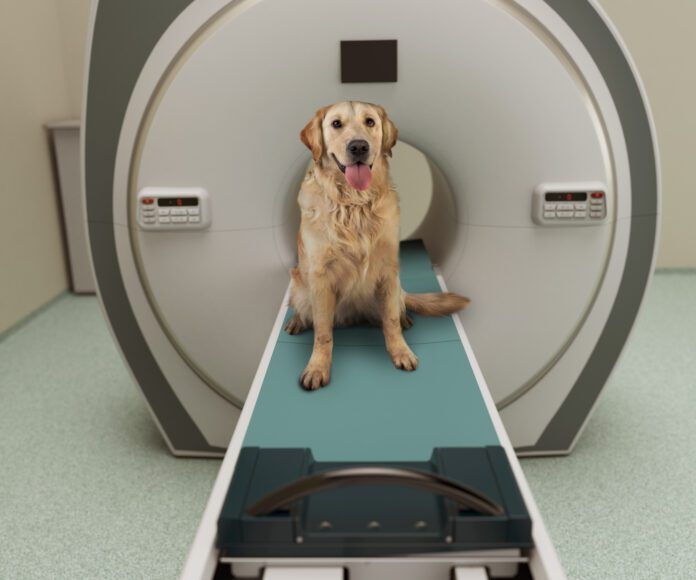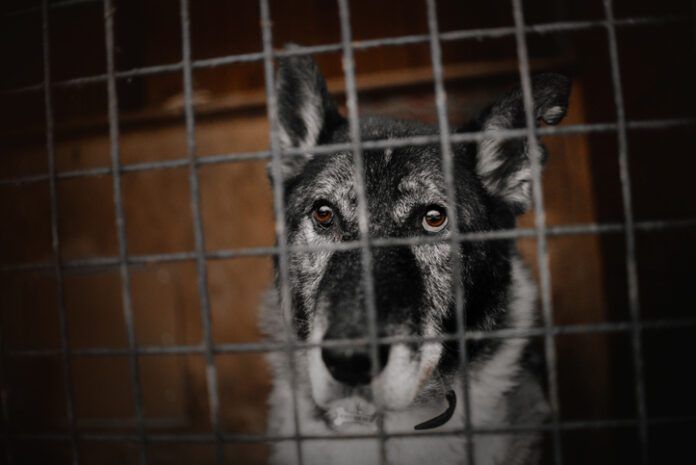Sundowners syndrome in dogs is officially called canine cognitive dysfunction syndrome, and may be abbreviated CCD or CDS. This is a degenerative disease, meaning that it will steadily get worse over time. Usually, we first notice that our senior dogs aren’t quite right, but over time the disorientation and mood swings become more dramatic and interfere with both your and your dog’s quality of life.
There is no specific test for canine cognitive dysfunction syndrome. Instead, you and your veterinarian will work together to determine if there are other health problems contributing to your dog’s behavioral changes or if they are the result of brain degeneration.
Symptoms of Sundowners in Dogs
Thanks to the Purina Institute, we do now have the DISHAA tool to help with diagnosing CDS. This simple tool is freely available online and will guide you through identifying behavioral changes that are associated with CDS and then giving your dog a score for each behavior. At the end, add up your dog’s total to determine how much he is affected by CDS. You can then use that information to start a conversation with your veterinarian and create a treatment and management plan.
There are six categories, each represented in the DISHAA acronym:
D – Disorientation
I – Social Interactions
S – Sleep/Wake Cycles
H – Housesoiling, Learning, and Memory
A – Activity
A – Anxiety
Disorientation
This is one of the easiest hallmarks of CDS for us to identify. Dogs suffering from sundowners may get lost in their own homes, struggle with navigating doorways and other physical obstacles, and get “stuck” in odd locations, such as behind a door or in a corner. You might also notice a vacant stare, as if your dog isn’t totally sure who you are or where they are.
Social Interactions
Dogs with CDS often become less social than they were during most of their lives. You may notice your dog becoming more fearful or even aggressive to strangers, and he may be less tolerant of your other pets. Some dogs also interact with their owners less, choosing to sit by themselves instead of asking for play or cuddles.
If you describe your dog as being “cranky” or a “curmudgeon,” he may be showing signs of canine cognitive dysfunction.
Sleep/Wake Cycles
This hallmark of CDS can be very difficult for us to handle. Dogs with CDS frequently switch to an abnormal sleep schedule, sleeping excessively during the day and then being awake at night. Worse, the nocturnal wakefulness often comes with pacing and fussing or whining.
Your dog may also sleep very deeply, which can be concerning when trying to wake him up.
Nighttime pacing, whining, and crashing into things (because our senior dogs also often have poorer nighttime vision) all combine to prevent us from getting a good night’s sleep. Over time this can lead to resentment, because while the dog gets to sleep all day, the humans often have to go to work. This makes altered sleep schedules one of the most common reasons that owners seek veterinary assistance.
Housesoiling, Learning, and Memory
Dogs affected by sundowners syndrome often forget behaviors that they once knew well (such as sit or come), and struggle to learn new things. They also may start eliminating in the house, seeming to forget how to ask to go outside or their housetraining.
Activity
Your dog’s activity may both increase and decrease as CDS progresses. Many dogs with this disorder become less active overall, no longer interested in long sniff walks or in play sessions. But other activities, especially repetitive ones like licking objects, chewing, walking in circles, or staring at the sky, may increase.
Anxiety
Anxiety can be another difficult symptom to manage and adjust to. You may notice that your dog is suddenly fearful of things he never cared about before, or that storm and noise phobias have gotten worse. Your dog may develop separation anxiety after a lifetime of being comfortable left at home alone. He may also get upset when introduced to new people or taken to new places.
Managing Dog Dementia
There is no cure for canine cognitive dysfunction syndrome, but there are ways we can slow its progression and treat symptoms to preserve your dog’s (and your!) quality of life. We’ll get into medications shortly, but first are some things you can do at home.
- Provide regular enrichment opportunities.
Just like human brains, dog brains need regular exercise. Since your dog probably isn’t going to be doing crossword puzzles, stimulate his mind by taking him on walks, using puzzle toys, and engaging in play and training time. All of these activities encourage him to be engaged in his surroundings and reinforce the brain pathways associated with each one.
Training time does not need to be aimed at formal or challenging skills. Choose fun tricks and behaviors that your dog can easily handle physically, and that he enjoys! You can also review basic obedience skills and old tricks that your dog knows well to both refresh his mind and give him an easy win.
- Make a routine.
Try to have a consistent routine for your older dogs. For example, wake up is at 7, breakfast at 7:30, short walk midday, longer walk or playtime after work, brief training session or playtime after dinner. Dogs with cognitive dysfunction like knowing what is going to happen next and having a routine helps them feel calmer.
Keeping your dog active during the day and having a consistent bedtime will also help to keep your dog on a normal sleep schedule.
- “Senior proof” the house.
Puppy proofing means going through the house to address all potential hazards (cover electrical cords, block stairs) and safeguarding things that might get chewed (your kids’ favorite toys, an heirloom quilt). Senior proofing is geared toward making sure your house is safe and accessible for your aging dog.
Keep furniture locations consistent so that your dog doesn’t get confused and can navigate your house or apartment easily. Also make sure that the entire family is onboard for picking up shoes, bags, and other personal items so your dog doesn’t trip.
Make sure that the flooring provides a good grip for your dog. If you have laminate or hardwood floors, put down runner rugs so your dog doesn’t slip.
Set up ramps or step stools to help your dog go up and down stairs and on and off furniture safely.
Provide nightlights if your dog likes to get a drink of water at night but is having trouble seeing in the dark. For one of my dogs, I used glow-in-the-dark tape to outline her ramp so she could get on and off the bed by herself at night.
Block off staircases and high furniture if your dog is unsteady on his feet and prone to falls. You can also put thick cushions on the floor by the couch or bed in case of stumbles.
- Frequent walks.
Plan frequent pee breaks to encourage your dog to eliminate outside and limit “accidents” in the house. Remember those early days when your tiny puppy needed to go out every two hours? Most senior dogs don’t need to go out quite that often, but experiment to determine what schedule works best for you and your dog.
Prescription Diets and Supplements for Senior Dogs
There are prescription diets and some supplements available that are geared toward supporting senior dogs mentally and physically.
Two prescription diets designed to help our aging dogs are Hill’s b/d and Purina NeuroCare. The Purina Pro Plan Bright Mind formula is an over-the-counter food that you can get at most pet supply stores. My current senior dog has been on the Bright Mind food for a couple months to hopefully support her brain and body as she enters her golden years. Only time will tell!
SAMe, Senilife, and supplements that contain omega-3 fatty acids such as fish oil may help support cognition in dogs. As with any supplement, check with your veterinarian before starting a new product to make sure that it isn’t likely to interfere with any of your dog’s current medications.
Medications for Sundowners in Dogs
There is only one medication that is FDA approved for canine cognitive dysfunction: selegiline or selegiline hydrochloride (brand name Anipryl). You may recognize this as an anti-depressant, and you’re correct. Selegiline works by limiting the breakdown of dopamine, which increases the circulating dopamine in your dog’s brain, as well as decreasing the number of free radicals in the brain.
Selegiline is given once a day and it may take up to two months to see an improvement. The good news is that about 76% of dogs respond to this therapy and have a decrease in symptoms. I was one of the lucky ones with my dog—her nocturnal pacing stopped within a week of starting selegiline and her mood improved.
As with anything that your dog takes by mouth, selegiline can cause vomiting, diarrhea, and a poor appetite in some dogs. Other possible side effects include tremors, drooling, disorientation, and restlessness. Selegiline also does not play well with some other medications, so your dog’s veterinarian will weigh pros and cons before prescribing it for your dog.
We do have other ways to approach the symptoms of CSD and improve your dog’s quality of life. Most important is pain relief. Many of our senior dogs have arthritis or other painful conditions and adequate pain relief does wonders for improving their attitude and well-being. Depending on the symptoms of sundowners that your dog is experiencing, your dog may be prescribed medications to help with urinary incontinence, anxiety, and promoting normal sleep schedules.
You are Your Dog’s #1
You are the most important part of managing your dog’s canine cognitive dysfunction syndrome. Ask your veterinarian if you are concerned that your dog might have CDS and use the DISHAA tool to evaluate your dog’s current mental state. Then make changes around your house and to your dog’s routine to help him feel safe and happy throughout his golden years.






